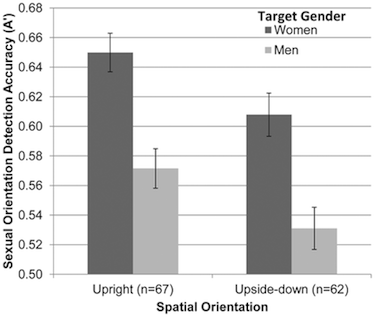Chance News 86
Quotations
Forsooth
Gaydar
The science of ‘gaydar’
by Joshua A. Tabak and Vivian Zayas, New York Times, 3 June 2012
The definition of GAYDAR is the "Ability to sense a homosexual" according to internetslang.com.
In their NYT article, Tabak and Zayas say
Should you trust your gaydar in everyday life? Probably not. In our experiments, average gaydar judgment accuracy was only in the 60 percent range. This demonstrates gaydar ability — which is far from judgment proficiency. But is gaydar real? Absolutely.
At PLoS One is their complete research paper where subjects viewed facial photographs of homosexuals and straights; the subjects then had a short time to decide the sexual orientation. In their first experiment, the faces were shown upright only:
Twenty-four University of Washington students (19 women; age range = 18–22 years) participated in exchange for extra course credit. Data from seven additional participants were excluded from analyses due to failure to follow instructions (n = 4) or computer malfunction (n = 3).
In the second experiment, faces were shown upright and upside-down and the subjects had a short time to decide the sexual orientation:
One hundred twenty-nine University of Washington students (92 women; age range = 18–25 years) participated in exchange for extra course credit. Data from 16 additional participants were excluded from analyses due to failure to follow instructions (n = 12) or average reaction times more than 3 SD above the mean (n = 4).
According to the authors, “there are two components of “accuracy”: the hit rate which is “the proportion of gay faces correctly perceived as gay, and the false alarm rate” which is “the proportion of straight faces incorrectly perceived as gay.” The figure reproduced below (full version here) indicates that the accuracy was better when the target gender was women as opposed to men and the accuracy was better when the faces were upright as opposed to upside down. Presumably, random guessing would produce an “accuracy” of about .5.
- Figure 3. Accuracy of detecting sexual orientation from upright and upside-down faces (Experiment 2).
- Mean accuracy (A′) in judging sexual orientation from faces presented for 50 milliseconds as a function of the target’s gender and spatial orientation (upright or upside-down; Experiment 2). Judgments of upright faces are based on both configural and featural processing, whereas judgments of upside-down faces are based only on featural face processing. Error bars represent ±1 SEM.
Reproduced below are the detail results for the second experiment:
- Table 1. Hit and False Alarm Rates for Snap Judgments of Sexual Orientation in Experiment 2.
The author’s conclude with the following statement:
The present research is the first to demonstrate (a) that configural face processing significantly contributes to perception of sexual orientation, and (b) that sexual orientation is inferred more easily from women’s vs. men’s faces. In light of these findings, it is interesting to note the popular desire to learn to read faces like books. Considering how challenging it is to read a book upside-down, it seems that we read faces better than we read books.
Discussion
1. Gaydar "accuracy" seems to be defined in the paper as hit rate / (hit rate + false alarm rate) or, to use terms common in medical tests, positive predictive value = true positive / (true positive + false positive). The paper makes no mention of negative predictive value = true negative / (true negative + false negative). As is illustrated in the Wikipedia article, legitimate medical tests will tolerate a low positive predictive value because a more expensive test exists in the rare case that the disease is actually present; negative predictive values must be high to avoid potentially deadly false optimism. The situation here is somewhat different because the subjects were exposed to an approximately equal number of gays and straights whereas in medical tests, most people in the population do not have the “disease.”
2. Perhaps the analogy with medical testing is inappropriate. That is, an error is an error and no distinction should be made between the two types of errors. Consider the above table for the case of women and upright spatial orientation. The hit rate is .36 and the false alarm rate is .22. If we assume that the 67 subjects viewed 100 gay faces and 100 straight faces, then we obtain the following table for average values:
| Orientation | + | - | Total |
|---|---|---|---|
| Gay | 36 | 64 | 100 |
| Straight | 22 | 78 | 100 |
| Total | 58 | 142 | 200 |
This leads to Prob (success) = (36 + 78)/200 = .57; Prob (error) = (64 +22)/200 = .43 In effect, the model could be hidden tosses of a coin and the subjects, in an ESP fashion, guess heads or tails before the toss. Of course, a Bayesian would then assume a prior distribution and combine that with the results of the study to obtain a posterior probability and avoid any mention of p-value based on .5 as the null.
3. Why might the following be a useful way of assessing gaydar via a modification of the procedure used in the article? Repeat the second experiment with no gays.
4. Why might the following be a useful way of assessing gaydar via a modification of the procedure used in the article? Repeat the second experiment with no straights.
5. In case the reader feels that Discussion #3 and #4 are deceptive, see this Psychwiki which looks at the history of deception in social psychology:
deception can often be seen in the “cover story” for the study, which provides the participant with a justification for the procedures and measures used. The ultimate goal of using deception in research is to ensure that the behaviors or reactions observed in a controlled laboratory setting are as close to those behaviors and reactions that occur outside of the laboratory setting.
Submitted by Paul Alper

